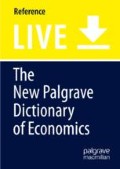Abstract
This article surveys recent work aimed at evaluating the welfare effects of campaign finance reform. The theoretical literature distinguishes two types of contributor: those who desire ideological policies and those who want personal favours. A series of models shows that these different types of contributor have different implications for campaign finance regulation. The models also give some suggestions about the sort of empirical evidence that would argue for or against certain campaign finance regulations. These suggestions have been followed up by recent empirical work.
This chapter was originally published in The New Palgrave Dictionary of Economics, 2nd edition, 2008. Edited by Steven N. Durlauf and Lawrence E. Blume
Bibliography
Ansolabehere, S., and J.M. Snyder Jr. 2002. The incumbency advantage in U.S. elections: An analysis of state and federal offices, 1942–2000. Election Law Journal 1: 315–338.
Ansolabehere, S., J.M. de Figueiedo, and J.M. Snyder Jr. 2003. Why is there so little money in U.S. politics? Journal of Economic Perspectives 17(1): 105–130.
Ashworth, S. 2006. Campaign finance and voter welfare with entrenched incumbents. American Political Science Review 100: 55–68.
Austen-Smith, D. 1987. Interest groups, campaign contributions, and probabilistic voting. Public Choice 54: 123–139.
Baron, D.P. 1989. Service-induced campaign contributions and the electoral equilibrium. Quarterly Journal of Economics 104: 45–72.
Baron, D.P. 1994. Electoral competition with informed and uninformed voters. American Political Science Review 88: 33–47.
Coate, S. 2003. Political competition with campaign contributions and informative advertising. Journal of the European Economic Association 2: 772–804.
Coate, S. 2004. Pareto-improving campaign finance policy. American Economic Review 94: 628–655.
Erikson, R.S., and T.R. Palfrey. 1998. Campaign spending and incumbency: An alternative simultaneous equations approach. Journal of Politics 60: 355–373.
Erikson, R.S., and T.R. Palfrey. 2000. Equilibria in campaign spending games: Theory and data. American Political Science Review 94: 595–609.
Gelman, A., and G. King. 1990. Estimating incumbency advantage without bias. American Journal of Political Science 34: 1142–1164.
Gerber, A. 1996. Rational voters, candidate spending, and incomplete information: A theoretical analysis with implications for campaign finance reform, Working Paper No. 96–01.1, Institution for Social and Policy Studies, Yale University.
Gerber, A. 1998. Estimating the effect of campaign spending on senate election outcomes using instrumental variables. American Political Science Review 92: 401–411.
Gerber, A.S. 2004. Does campaign spending work?: Field experiments provide evidence and suggest new theory. American Behavioral Scientist 47: 541–574.
Gordon, S.C., and C. Hafer. 2005. Flexing muscle: Corporate political expenditures as signals to the bureaucracy. American Political Science Review 99: 245–261.
Green, D.P., and J.S. Kranso. 1988. Salvation for the spendthrift incumbent: Reestimating the effects of campaign spending in House elections. American Journal of Political Science 32: 884–907.
Grossman, G.M., and E. Helpman. 1996. Electoral competition and special interest politics. Review of Economic Studies 63: 265–286.
Hall, R.L. 1996. Participation in Congress. New Haven: Yale University Press.
Houser, D., and T. Stratmann. 2006. Selling favors in the lab: Experiments on campaign finance reform, Working Paper No. 1727, CESifo.
Jacobson, G.C. 1978. The effects of campaign spending in Congressional elections. American Political Science Review 72: 469–491.
Jacobson, G.C. 2001. The politics of congressional elections, 5th ed. New York: Addison-Wesley Educational Publishers, Inc.
Kroszner, R.S., and T. Stratmann. 1998. Interest Group competition and the organization of congress: Theory and evidence from financial services political action committees. American Economic Review 88: 1163–1187.
Levitt, S.D. 1994. Using repeat challengers to estimate the effect of campaign spending on election outcomes in the U.S. House. Journal of Political Economy 102: 777–798.
McCarty, N., and L.S. Rothenberg. 1996. Investment in politicians? Evidence from the 1994 elections. Paper presented at the 1996 annual meeting of the American Political Science Association, 29 August–1 September.
Morton, R., and C. Cameron. 1992. Elections and the theory of campaign contributions: A survey and critical analysis. Economics and Politics 4: 79–108.
Morton, R.B., and R.B. Myerson. 1992. Decisiveness of contributors’ perceptions in elections. Working paper, New York University.
Potters, J., R. Sloof, and F. van Winden. 1997. Campaign expenditures, contributions, and direct endorsements: The strategic use of information to influence voter behavior. European Journal of Political Economy 13: 1–31.
Prat, A. 2000. Campaign spending with office-seeking politicians, rational voters, and multiple lobbies. Journal of Economic Theory 103: 162–189.
Prat, A. 2002. Campaign advertising and voter welfare. Review of Economic Studies 69: 997–1017.
Prat, A. 2006. Rational voters and political advertising. In The Oxford handbook of political economy, ed. B.R. Weingast and D. Wittman. Oxford: Oxford University Press.
Romer, T., and J.M. Snyder Jr. 1994. An empirical investigation of the dynamics of PAC contributions. American Journal of Political Science 38: 745–769.
Snyder, J.M. 1990. Campaign contributions as investments: The U.S. House of Representatives, 1980–1986. Journal of Political Economy 98: 1195–1227.
Stratmann, T. 2006. Contribution limits and the effectiveness of campaign spending. Public Choice 129: 461–474.
Stratmann, T., and F.J. Aparicio-Castillo. 2006. Competition policy for elections: Do campaign contribution limits matter? Public Choice 127: 177–206.
Author information
Authors and Affiliations
Editor information
Editors and Affiliations
Copyright information
© 2008 The Author(s)
About this entry
Cite this entry
Ashworth, S. (2008). Campaign Finance, Economics of. In: The New Palgrave Dictionary of Economics. Palgrave Macmillan, London. https://doi.org/10.1057/978-1-349-95121-5_2749-1
Download citation
DOI: https://doi.org/10.1057/978-1-349-95121-5_2749-1
Received:
Accepted:
Published:
Publisher Name: Palgrave Macmillan, London
Online ISBN: 978-1-349-95121-5
eBook Packages: Springer Reference Economics and FinanceReference Module Humanities and Social SciencesReference Module Business, Economics and Social Sciences

